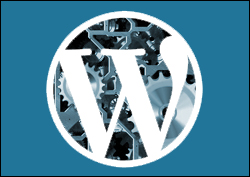
Welcome to Part Three of our Website Traffic Blueprint article series, where we show you how to turn your website into an automated web traffic machine using the WordPress CMS.
In Part 1 of this article series, we explained why using an expertly configured WordPress site is the key to automating traffic to your site …
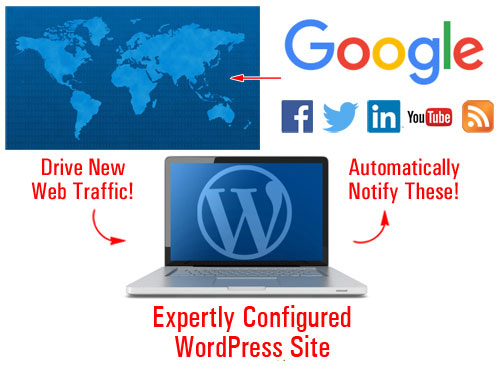
(With an expertly configured WordPress blog, all you have to do to automatically begin bringing web traffic is post new content on a regular basis!)
In Part 2, we focused on the setup phase. We helped you understand the best way to start if you don’t have a web presence yet, how to set everything up if you already have a website, and what to do if your existing site was built using WordPress.
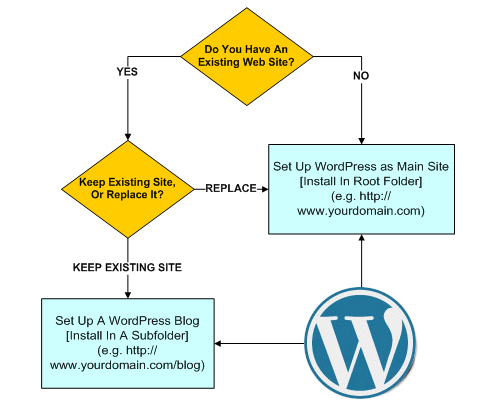
(In Part two we show you how to set up a WordPress website on your domain)
In this section of the series, we will look at the configuration stage of this process. We will show you how a WordPress site should be configured in order to bring traffic automatically simply by regularly posting web content to your website.
WordPress Traffic System – Configuration Phase
The ability to attract more visitors to one’s website is often cited by many business owners as one of their greatest challenges online. Also, the business landscape is becoming so much more competitive on a global scale and businesses are researching any and every opportunity they can to increase their competitiveness online.
Having the ability to generate traffic on demand can provide you with a tremendous advantage over the competition. For WordPress users, an expertly configured website allows their business to get off with a flying start from the moment their website is launched.
The Configuration Process Is What Makes The Difference
There is a significant difference between an expertly configured WordPress site and a website that has been professionally installed and set up by an expert website developer but not necessarily configured to take advantage of everything WordPress can offer you.
Here’s one way to understand the difference:
An expertly configured WordPress site gives you a professional web presence plus an automated online business marketing system!
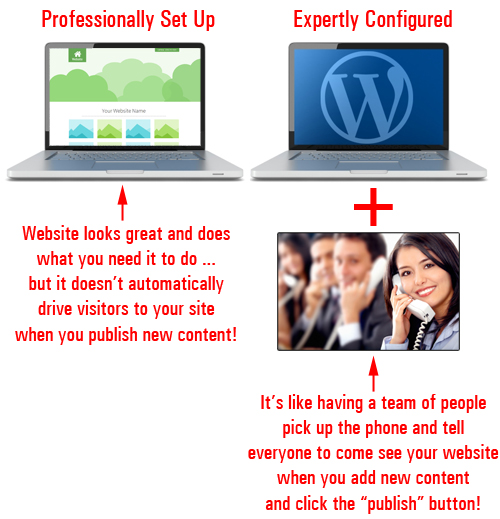
(An expertly configured site gives you a professional web presence with an automated online business marketing tool!)
Not only does it take extra labor to build and integrate an automated online business marketing system into your website, it also takes a special kind of expert knowledge.
To illustrate this here’s an anecdote.
A Semi-True Story …
Everything is going just fine in the gizmo manufacturing plant when things grind to a sudden halt.
No one can figure out what is wrong and so the manager decides to call in an expert to try and fix the problem.
Shortly after arriving, the expert heads immediately towards the main control box. After staring silently at the wiring board for less than 3 minutes, the expert then produces a tiny hammer and makes a very gentle tap about three inches from the top-right corner of the box.
Immediately, the machinery springs back to life.
The manager is greatly overjoyed as he thanks the expert, who then leaves as quickly as he had arrived.
A couple of days after resolving the incident, the manager receives a request of payment for services rendered totalling $5,000.
Feeling furious, the manager dials the expert. Why did he charge them such a ridiculously high fee for so little time spent delivering a minimal amount of work? He promptly requests an itemized invoice and hangs up.
The next day, an invoice arrives and is placed in the manager’s in-tray. Upon opening it, this is what he sees:
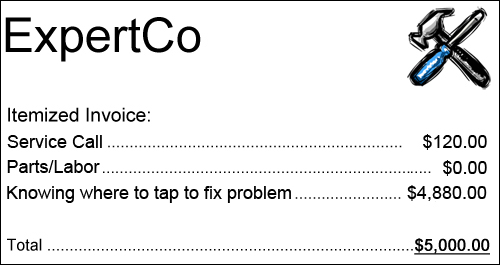
The number one challenge most businesses face online is being able to drive new visitors consistently to their sites.
How much money did the plant stand to lose when the equipment ground to a halt and no one in the factory floor was able to fix it? Did the expert not have every right to demand fair compensation for having spent years acquiring the knowledge, skills and expertise that enabled him to quickly assess and fix a very costly problem?
Similarly, if you could have a WP website set up and configured so all you had to do is publish new content and search engines, social media and dozens of other traffic-generating web properties would be immediately notified, how much time and money would you save?

(How much time and money would you save if you could automate the process of attracting new visitors to your site?)
Although experts often make complicated things look easy, it rarely turns out to be that way.
Knowing how to expertly configure a WordPress site involves more than simply installing a website and configuring settings for a client. It involves knowing where to tap! This includes knowing things like:
- Which plugins need to be installed for certain things to occur on your site.
- Which third-party accounts need to be set up to get specific outcomes
- Which internal and external settings you need to configure to ensure that everything will work as expected, etc.
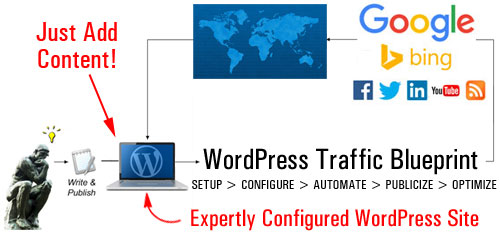
(Driving traffic automatically with WordPress is a process that requires expertise)
This part of the WordPress traffic automation system is not technically challenging, but it’s quite complicated. It’s not as simple as installing a plugin, tweaking some options and settings in your dashboard area or clicking a button … it’s all this and so much more.
Expertly configuring your website is a complex process that involves your web server, your website or blog, and various third-party sites and services …
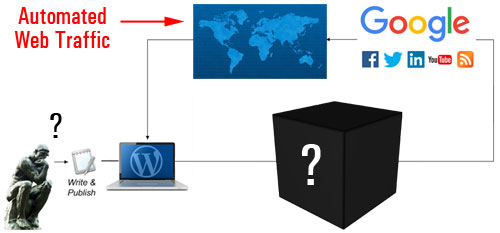
(Expertly configuring your website involves more than just configuring a few WordPress settings)
If we were to create a simple diagram showing the activities involved in the configuration process, it would look something like this …
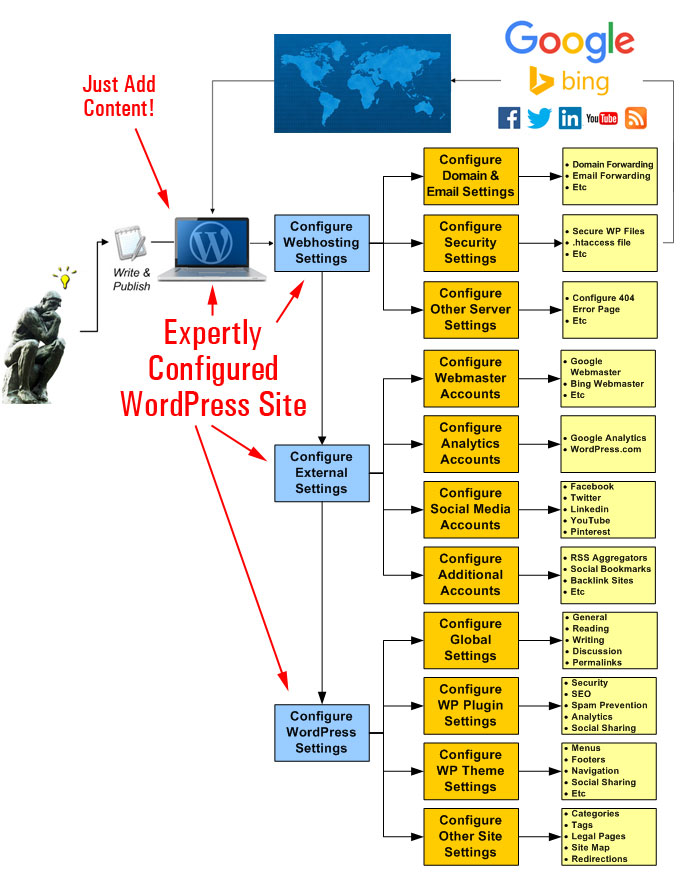
(A simplistic diagram of the steps involved in the configuration process)
Let’s examine these areas in more detail.
Your Server
We’re not talking here about the process of configuring your webhosting account for website installation purposes (this should have been done during the Setup phase). We’re talking about tweaking settings and options in your web server specifically for handling all web traffic …
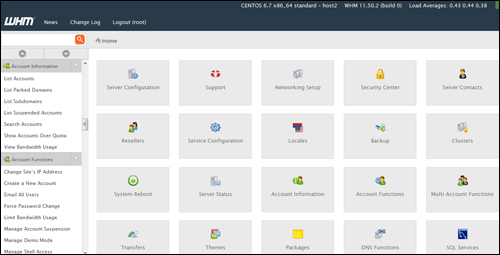
(In the configuration stage, your server settings need to be checked for handling both good and bad traffic)
Not all traffic is positive traffic. Some of the traffic you may attract will be unwanted traffic like bot spam, security threats, bot-hacking attempts, etc.
This part of the configuration process, therefore, requires planning for good and bad traffic and then adjusting settings in your server accordingly. This includes looking at things like server-level spam protection and threat prevention, to configuring your domain and email forwarding, setting up htaccess file redirections, etc …
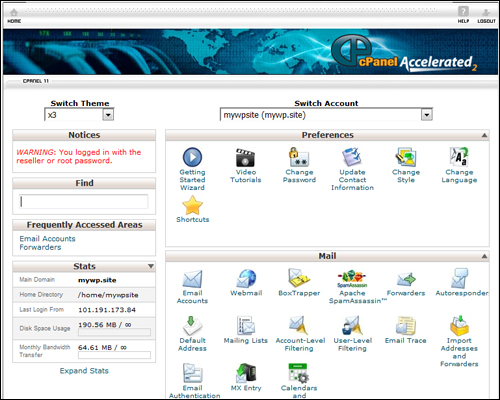
(Have you configured your control panel settings for handling things like emails, page errors, etc?)
Once your server settings have been fine-tuned and configured (if required), the next step is to set up and configure a number of external sites and online solutions.
External Sites And Services – Configuration
The purpose of setting up external sites is that all content should be posted to a central location (your site) and from there, be automatically distributed to other components of your web traffic system, or notify traffic-related web properties and applications.
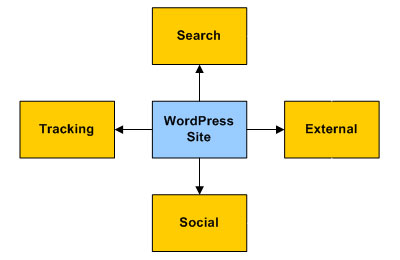
After incorporating these external platforms into your traffic network, content linked back to your website gets automatically posted to your search, social and aggregator accounts. Your content and site will receive exposure online, helping your business tap into new audiences and new sources of traffic.
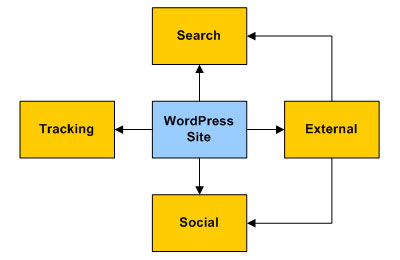
Some of the third-party web properties and online services will need to have accounts set up before configuring your settings to save time and some will need to be done later, during the automation phase.
For example, here are just some of the accounts you will need to have set up:
Google Webmasters
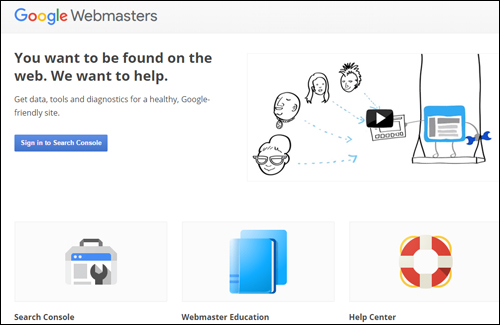
(Google Webmaster Tools – create a Google-friendly site)
Google Search Console lets you inform Google about your site’s pages, submit XML sitemaps for automatic page indexing, and provides you with important data, tools and reports about your website.
Once your account and site details with Google Webmasters have been set up, your information can be used with traffic-related settings in WordPress and other applications.
Google Analytics

(Google Analytics)
Google Analytics lets you improve your site’s traffic performance, SEO, marketing efforts, and more, by tracking all user behavior, pages visited, keywords searched for, organic referrers, etc.
Once your Google Analytics account and site data have been set up, you can add visitor tracking information to all of your web pages in WordPress via any of several Google Analytics plugins and feed data instantly to many other useful applications and reporting tools.
Bing Webmaster Tools
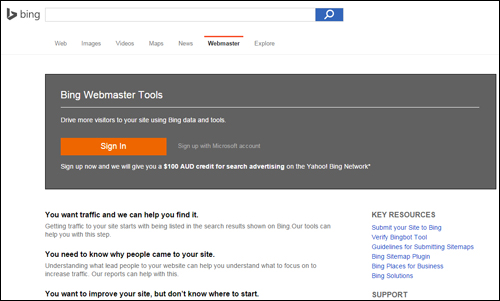
(Drive more traffic with Bing Webmaster Tools)
Bing Webmaster Tools is similar to Google Webmaster Tools. After setting up your account with Bing Webmaster Tools, this information can be used with traffic settings and notifications in WordPress using plugins like Yoast SEO (see further below) and other applications.
WordPress.com
(WordPress.com)
As discussed in Part 2, WordPress offers website owners a self-hosted and a hosted option. We recommended choosing the self-hosted WordPress version if you plan to build a professional web presence.
WordPress.com (the hosted option), however, provides some great features, which a number of WordPress plugins can access. We recommend setting up an account with WordPress.com, therefore, and we’ll show you how to integrate this into your automated web traffic generation system in Part 4 of this series.
Social Media And Social Bookmarking
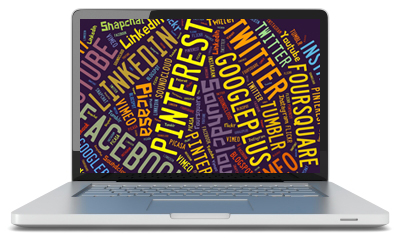
(Syndicate your content automatically to your social media sites and social bookmarking accounts and bring new visitors to your site)
You will need your various social media accounts set up in order to configure these as part of your traffic generation system.
After setting up and configuring everything, you will be able to syndicate your content automatically to your social media and social bookmarking accounts and get new visitors to your site.
You should have accounts and pages set up with all the leading social networks – Facebook, Twitter, Pinterest, LinkedIn, YouTube, etc.

There are loads of social sites you can post your content to. You don’t need to create accounts with all of them, just choose those that will work with your system and/or content sharing tools (we cover some of these tools in more detail when we discuss the Automation phase).
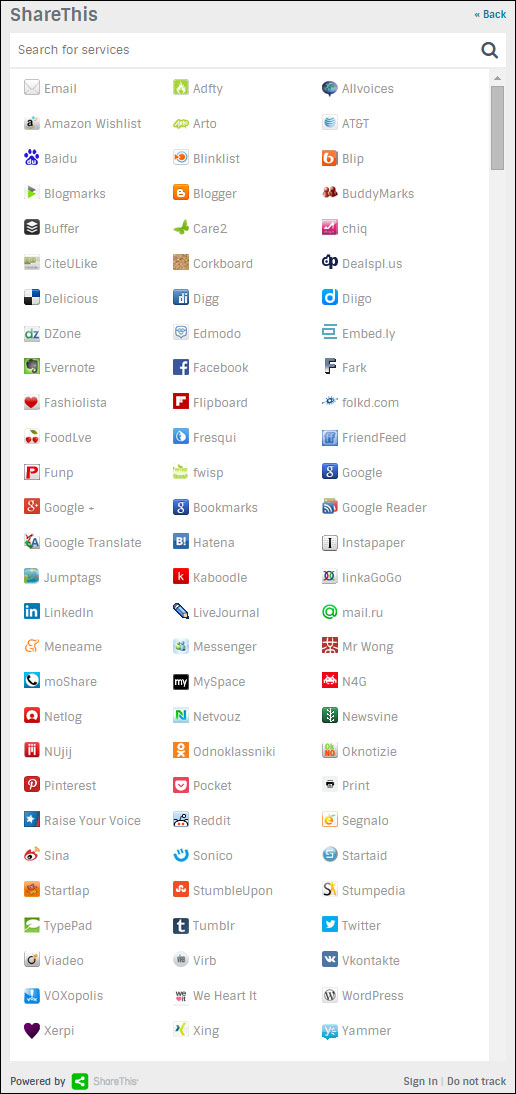
(There are lots of social bookmarking sites you can post your content to. Image source ShareThis.com)
Additional Services, Content Aggregators, Etc.
There are many emerging technology platforms and RSS aggregators that can serve as secondary traffic generation sources. Some are free or provide free accounts, and some are more suitable for enterprise-level applications.
For example, here is a content aggregator site that lets you add an RSS feed from your site …
RebelMouse
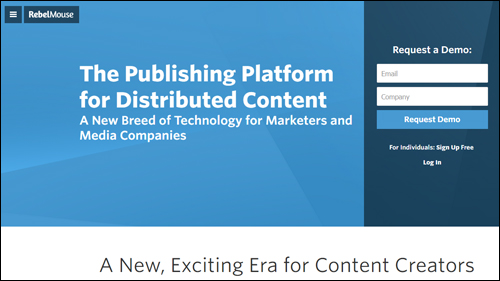
(RebelMouse)
RebelMouse is an aggregator for your social profiles and RSS feeds. Your content is displayed in a Pinterest-like format and visitors can follow your account.
![]()
There are various platforms that can be incorporated into your own traffic system. Please feel free to contact us if you need assistance exploring some of these further, or to discuss a strategy to suit your needs.
After you have configured your server settings and set up accounts with external services, it’s time to configure your site.
WordPress Traffic Configuration
The first step in configuring your WordPress site for traffic is to ensure that your global settings have been set up correctly.
Let’s go over some of the important points.
Configuring Global WordPress Settings
The WordPress admin area contains a Settings menu that allows you to configure your site’s global settings …

(WordPress menu – Settings)
General Settings
Sections like Site Title and Tagline can affect your site’s SEO, search listings, etc …
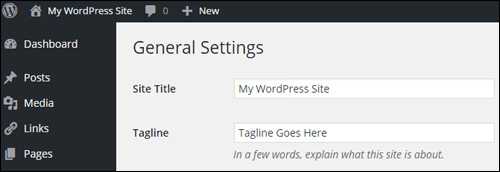
(Settings Menu – General Settings)
Writing Settings
The Writing Settings area contains one of the most powerful and frequently overlooked automated traffic notification systems available to WordPress site owners …

(Global Settings – Writing Settings)
As stated in the Update Services section,
When you publish a new post, WordPress automatically notifies the following site update services …
Unless you have purposely configured your site settings to discourage search engines from indexing your site, then your site will automatically ping the list of update services entered into the Update Services text area
With an ‘out of the box’ WordPress installation, only one service is listed …

(WordPress Update Services)
WordPress lets you notify dozens of update services automatically – just add a list of update services to this section …

(Notify dozens of update services automatically!)
![]()
Download A Comprehensive List Of Ping Services For Your WordPress Site!
Click the link below to download a comprehensive list of reliable and authoritative ping services for your WordPress site or blog:
Download A List Of Ping Services For Your WordPress Site
***
Note: If you need help setting up the list of ping services on your site, we recommend using a professional web services provider. You can find professional WordPress service providers in our WordPress Services Directory.
Reading
This section affects how your content gets seen by visitors when they visit your home page and blog pages.
The syndication settings in this section can influence traffic. For example, choosing to display the full content vs a summary of your post, affects how your content appears in RSS readers and RSS email campaigns, and could affect someone’s choice to explore your site further, and whether or not they will visit your website to read the rest of the content from excerpts, or read the content in full without the need to click through to your site.
As far as your traffic system is concerned, however, the most important setting in this section is whether the Search Engine Visibility feature is enabled or not.
Normally, you would want search engines to visit your site. Leaving this box unchecked enables your site to instantly ping various update services when new posts are published (see Writing Settings above). Unless you have a specific reason why search engines should not visit your site, make sure this box is left unticked …

(Global Settings – Reading Settings Screen)
Discussion
Although the settings in this section are mostly concerned with how users engage with content on your site, you have the option to allow notifications to sites linked to from your content, and to allow link notifications from other blogs (pingbacks and trackbacks). This can work for you, but it can also drive bad traffic in the form of SPAM comments …

(WordPress Settings – Discussion Settings)
Permalink Settings
Your Permalink settings allow you to create SEO-friendly URLs …

(Settings Menu – Permalinks)
The examples below show some of the ways permalinks can be configured …

(Configuring permalink URLs)
We have written a detailed tutorial about using WordPress permalinks here: How To Improve Your WordPress SEO With Permalinks
WordPress – Traffic Plugins
WordPress provides users with thousands of plugins that help to add just about every type of functionality imaginable to your site, including plugins with features that help to improve traffic generation.
Let’s look at examples of plugin categories and plugins that can help your site generate more traffic
Security Plugins – Blog Defender
Once again, it’s important to configure your WordPress site for dealing with the effects of both good traffic and bad traffic. Regardless of the kind of business you run or plan to run online and how small you think your web presence is, you simply cannot ignore the importance of securing your web sites.
 (Security Plugins help prevent bad traffic from causing your website harm)
(Security Plugins help prevent bad traffic from causing your website harm)
Security plugins like Blog Defender help to make your website invisible to hackers and botnets.
Go here to learn more:
SEO Plugins – Yoast SEO
SEO plugins help drive traffic by making your web pages more indexable …

(WordPress SEO Plugin – Yoast SEO)
Use a plugin like Yoast SEO to improve your SEO. Once properly configured, the Yoast SEO plugin not only makes your web pages easier for search engines to find and index, it also lets you configure how your content will show up in Google’s search results and social media pages, e.g. Twitter, Facebook, and GooglePlus.
WordPress Social Plugins
Allowing your visitors to easily share your content with others can help drive significant traffic to your site, especially if your site provides content that adds value to readers.

(You can add social features to your site easily with WordPress plugins)
WordPress users can easily add social sharing to their site using free or inexpensive plugins.
Many social plugins let you choose which social sites your content can be shared to, embed social buttons into your content, set up custom update notifications, display/hide share counters (e.g. number of likes), etc. Some social sharing plugins even allow you to set up protected content sections on your site which visitors can unlock by liking your page.
Theme Settings
As well as configuring various plugins, many WordPress themes also include features that can help grow your site’s traffic.
For example, in addition to options and settings for configuring layout and design elements of your site, some themes also provide built-in features that let you improve search optimization and site linking structure for faster indexing, add analytics code, social sharing buttons, etc …

(Many WordPress themes allow you to configure options and settings for improved traffic results)
With many themes, adding social sharing buttons and features to your website is as easy as clicking a button …

(Many WordPress themes provide built-in social sharing features that can be easily turned on with the click of a button)
WordPress Traffic – Other Important Aspects To Consider
Last but not least in the traffic configuration process, are the elements that need to be configured outside of the global settings.
This includes the following:
Website Legal Pages
Once again, when preparing your website for a growth in traffic, it’s important to plan not only for both bad and good traffic but also for all the situations that can hurt your business as more and more people find and begin to visit your website.
If you are making money online, it’s important that your site complies with regulatory agencies.
 (Does Your Website Or Blog Comply With All Legal Requirements?)
(Does Your Website Or Blog Comply With All Legal Requirements?)
If you need help understanding how to quickly add legal pages to your site, see this article:
WordPress Post Tags & Post Categories
WordPress categories & tags help to improve your site’s SEO, which helps you get more traffic.

(WordPress categories help to improve your site’s SEO, which helps you get more traffic.)
As we recommend in this article, your website’s post categories and tags should be set up earlier on, during the Website Planning Stages.
In the configuration phase, you will want to review and make sure that your site’s post categories and tags have been set up correctly to deliver optimal benefits and results.
Add A Site Map
A visitor site map that displays all of your posts and pages is not only a useful navigation tool for users, it can also help external applications discover more of your online content …

(A site map is not just great for visitors, but for web traffic too!)
![]()
An HTML site map and an XML sitemap are not the same things. Although Google can index your pages just from an XML sitemap (which a plugin like Yoast SEO will create for you – see earlier section), allowing visitors to find more pages on your site can result in increased traffic.
Configure Your WordPress 404 Page
When visitors searching for your site enter the wrong URL into their web browser or click on a link pointing to a page on your site that no longer exists, they are presented with a 404 Not Found page …

(A WordPress 404 Page)
Configuring your 404 page allows you to redirect traffic that may otherwise be lost. …

(Configuring your 404 Not Found error page allows you to redirect web traffic that may otherwise be lost.)
![]()
Although a 404 Not Found error page can be set up on your server, there are several plugins for WordPress that let you easily configure your 404 page inside your WordPress admin area.
WordPress Traffic Automation Blueprint: Configuration Process – Summary
Once you have your site fully set up and expertly configured, all you have to do then to automatically start generating new web traffic is publish fresh content on a regular basis.
The process of expertly configuring a WordPress site, however, is quite involved and requires the configuration and integration of different elements and external web properties …

(Traffic System – Configuration Checklist)
![]()
The kind of skills and knowledge required to perform the configuration stage of the traffic automation process typically takes many website developers a long time to acquire.
Once you have configured your WordPress site, the next step is to automate as much of the process as can be automated. This step is explained in the next article in the WordPress Traffic Automation System series.
This is the end of Part Three
To keep reading, click on the link below:

![]()
This article is part of a comprehensive tutorial series aimed at helping website owners learn how to grow their business online cost-effectively with a WordPress-powered website or blog and proven online marketing methods.
Would You Like To Get Automatically Notified When New WordPress Tutorials Are Published? Then Subscribe Using The Form Below!
***
"I love the way your email series "Infinite Web Content Creation Training Series" is documented and presented. It is very absorbing and captivating. The links and tutorials are interesting and educational. This has motivated me to rewrite my content following the concepts I am learning from the email series." - Mani Raju, www.fortuneinewaste.com
***
